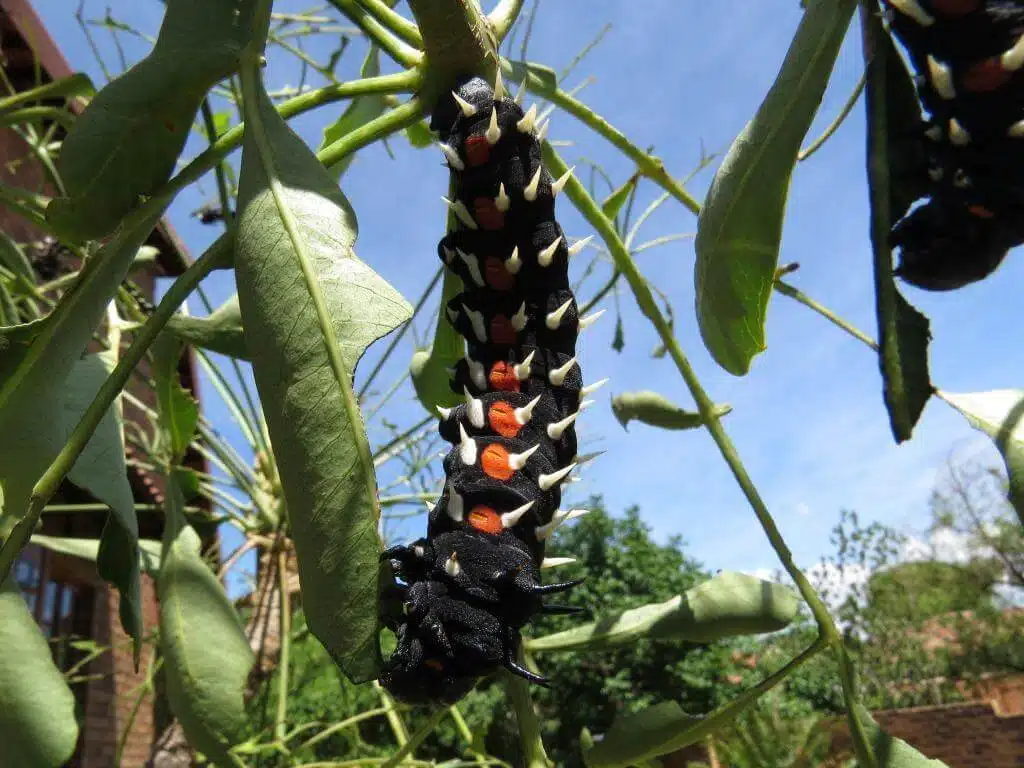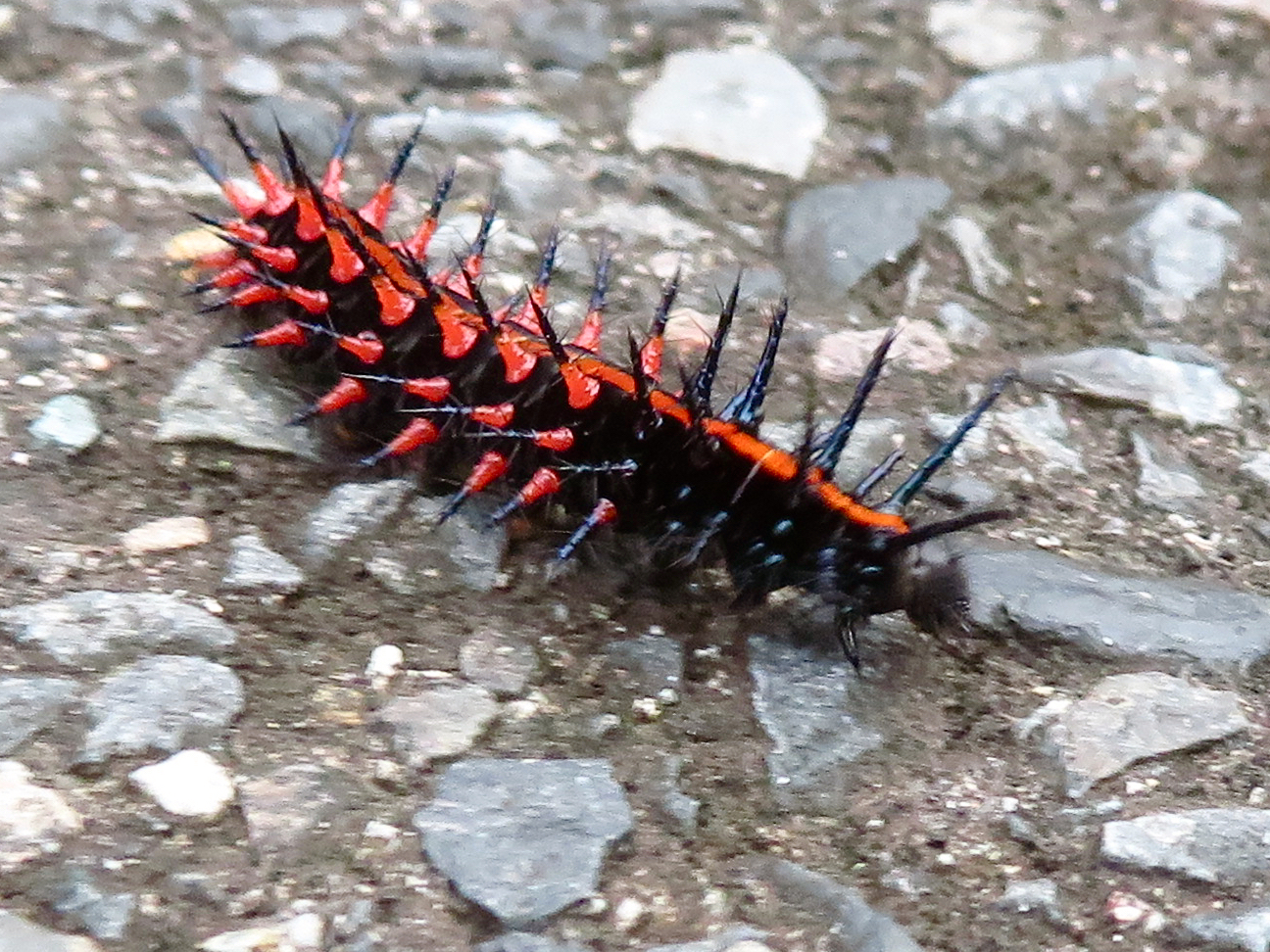Some rare types of caterpillars are black and red. These types of caterpillars can be found in high numbers in their natural habitat but may still seem elusive compared to dominant green caterpillars.
Moths and butterflies of the world are often seen in black and red colors.
These may be the main colors of caterpillars throughout their growth stages or they may only be the contrasting colors they grow into their late growth stages.
Black and red caterpillars are often found in North America. They can even grow black and red hairs or spines.
Aposematic coloring is specific to these caterpillars. These types of highly contrasting colors repel predators.
An evolutionary adaptation, aposematic coloring is specific to most of the following black and red caterpillars found in North America, Europe, or elsewhere around the world.
Table of Contents
1. Giant Woolly Bear

Giant Woolly Bears (Hypercompe scribonia) are some of the most widespread types of black and red caterpillars.
The colors of the caterpillar dominate individual segments across the body. Seen covering 2 or 3 segments together, they are alternatives across the body of the caterpillar.
Initially seen with just a few short black hair coverings its orange-red and black abdominal segments, this is a species that slowly becomes a black hairy caterpillar.
Its long and dense black hairs cover its body which tends to become red from an initial orange-red nuance.
These black hairs play a defensive role but this caterpillar also eats and absorbs toxins of its host plants as a form of defense.
Cabbage and lemon are some of its many types of hosts.
2. Azalea Caterpillar

The Azalea Caterpillar (Datana major) is a species with red and black nuances across its body in its late instars.
Initially, this caterpillar only has red and yellow nuances. Its red nuances are close to brown while its yellow initial color is bright.
As it grows, The Azalea Caterpillar starts to change its appearance.
It eventually becomes a species with vivid red or red-brown prolegs. Its body becomes yellow with multiple longitudinal black stripes.
Named after its Indica azaleas hosts, these types of caterpillars may require management, especially in their Southern range.
Azalea Caterpillars of Florida tend to cause the most damage to their host flowers.
3. Cabbage Tree Emperor Caterpillar

The Cabbage Tree Emperor Caterpillar (Bunaea alcinoe) is one of the largest black and red caterpillars in the world.
Born from a spherical white egg, this caterpillar ends up measuring 2.8 inches in its final instar.
A mostly black appearance is specific to The Cabbage Tree Emperor Caterpillar.
Red sections are seen across its body while its dorsum is further contrasted by black and white tubercles.
While black and red nuances are dominant, its white tubercles make the caterpillar take on a different look in front of predators.
Numerous hosts are noted for this species, including orchid tree varieties.
4. Pipevine Swallowtail Caterpillar

Pipevine Swallowtail Caterpillars (Battus philenor) are often black and red.
A black color dominates the appearance of these caterpillars that grow to just over 2 inches.
Small red and black tubercles are later seen in this species.
Pipevine Swallowtail Caterpillar may also come in a completely different color combination depending on their region.
For example, the caterpillars in the warmer South US climates are red and may have red or orange tubercles.
Females of the species are known to select the host plants depending on their chemical cues.
Males are also involved in the host plant selection process.
They fly around females on host plants and rarely live in the area of the host plants until breeding,
5. Mourning Cloak Caterpillar

A colorful appearance is specific to Mourning Cloak Caterpillars (Nymphalis antiopa).
This is a species with warning colors when it comes to self-defense. Highly contrasting red sections are seen on its black body which is also covered in spines.
A base black color is characteristic of The Mourning Cloak Caterpillar. This is a species with red or orange-red mid-dorsal spots arranged in a line.
The prolegs of the species tend to be vivid red and not orange-red as these warning dorsal spots.
Short and long white hairs also cover the caterpillar. Black spines are also characteristic of this species.
Both the hairs and the spines are visible on the late instar Mourning Cloak Caterpillar, a stage in which it reaches a size of over 2 inches.
6. Indian Lily Caterpillar

Black and red colors appear on Indian Lily Caterpillars (Polytela gloriosae) throughout their instars or life stages.
These are the types of caterpillars that change their appearance within days, as they go from one instar to another.
A red-brown nuance is backed by a black dorsal color with white spots in its initial growth stages.
The species slowly darkens to a brown color and eventually becomes mostly black with a few red spots on its dorsum.
Aposematic coloring is characteristic of the species. This means it uses a contrasting appearance to keep predators at a safe distance.
In the case of Indian Lilly Caterpillars, a black appearance is contrasted by red, orange-red, and white spots to confuse predators and keep them away.
As its name implies, this type of caterpillar can be spotted on Zephyranthes ornamental family of flowers such as fairy lilies.
7. Tropical Fritillary Caterpillar

A mostly black color covers the dorsal side of The Tropical Fritillary Caterpillar (Argynnis hyperbius).
This is a species with a red-brown mid-dorsal stripe. It also shows red-brown and black spines across its dorsum.
Other variants of the species also exist. These include orange, pink, and black, or purple and black caterpillar color combinations.
The early instar Tropical Fritillary Caterpillar is mostly orange or red with black being a secondary color before turning a primary color.
Mostly black, the caterpillar is seen with a different bright color combination to keep predators away. Tropical Fritillary Caterpillars are found in different regions of the world. This includes regions of Southeast Asia and East Asia as well as regions of Australia.